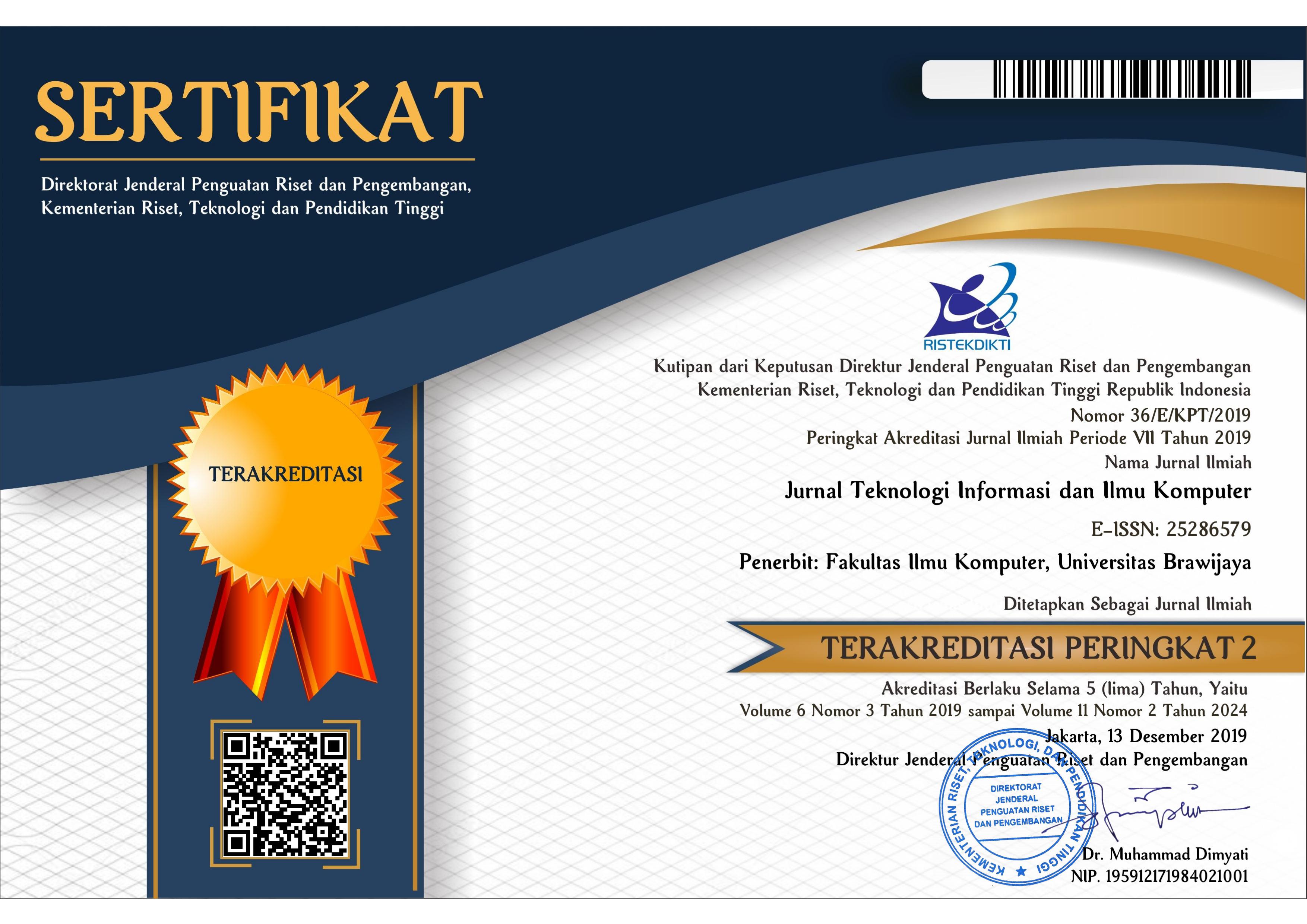Identifikasi Dini Curah Hujan Berpotensi Banjir Menggunakan Algoritma Long Short-Term Memory (Lstm) Dan Isolation Forest
DOI:
https://doi.org/10.25126/jtiik.938718Abstrak
Curah hujan yang tinggi merupakan faktor utama yang dapat mengakibatkan banjir di suatu daerah. Pola curah hujan yang semakin tidak teratur dan peningkatan curah hujan ekstrem membuat pengendalian banjir semakin sulit. Identifikasi dini diperlukan untuk memahami peran curah hujan dalam manajemen sumber daya air dan perancangan infrastruktur air yang tangguh untuk daerah rawan banjir. Dengan keterbatasan data dan parameter input tunggal, model yang diusulkan menghadapi tantangan dalam forecasting pola curah hujan jangka panjang dan generalisasi data. Studi ini memproses data curah hujan BMKG untuk menghasilkan forecasting menggunakan Long Short-Term Memory (LSTM) berdasarkan pola data series dan hubungan jangka panjang. Algoritma Isolation Forest kemudian digunakan untuk mengidentifikasi secara otomatis curah hujan dengan potensi banjir. Probabilitas curah hujan tinggi diidentifikasi untuk menghitung ketahanan infrastruktur air dan menetapkan standar yang sesuai untuk daerah beriklim hujan dan rawan banjir. Prediksi LSTM dievaluasi menggunakan Mean Square Error (terbaik 19,11) dan Root Mean Square Error (terbaik 4,37) sebelum dilakukan forecasting jangka panjang. Model yang diusulkan bertujuan untuk membantu pemangku kepentingan secara cepat mengidentifikasi probabilitas curah hujan tinggi jangka panjang, khususnya di daerah Semarang.
Abstract
High rainfall is a key factor causing floods in an area. Increasingly irregular rainfall patterns and rising extreme rainfall make it more challenging to control floods. Early identification is needed to understand rainfall's role in water resource management and designing resilient water infrastructure for flood-prone areas. With limited data and single input parameters, the proposed model faces challenges in long-term rainfall pattern forecasting and data generalization. This study processes BMKG rainfall data to generate forecasts using Long Short-Term Memory (LSTM) based on data series patterns and long-term relationships. The Isolation Forest algorithm is then used to automatically identify rainfall with flood potential. The probability of high rainfall is identified to calculate water infrastructure resilience and set appropriate standards for rainy, flood-prone areas. LSTM predictions are evaluated using Mean Square Error (best 19.11) and Root Mean Square Error (best 4.37) before conducting long-term forecasting. The proposed model aims to help stakeholders quickly identify the probability of long-term high rainfall, particularly in the Semarang area.
Downloads
Referensi
ALDRICH, C., & LIU, X. 2024. Monitoring of Mineral Processing Operations with Isolation Forests. Minerals, 14(1), 76. https://doi.org/10.3390/min14010076.
AULIA, F., FARISI, A., SETYA PERDANA, R., ADIKARA, P. P., & KORESPONDENSI, P. 2023. Klasifikasi Intensi Dengan Metode Long Short-Term Memory Pada Chatbot Bahasa Indonesia. Jurnal Teknologi Informasi dan Ilmu Komputer (JTIIK), 10(7). https://doi.org/10.25126/jtiik.2023108000.
BAI, Y., YANG, E., HAN, B., YANG, Y., LI, J., MAO, Y., NIU, G., & LIU, T. 2021. Understanding and Improving Early Stopping for Learning with Noisy Labels. 35th Conference on Neural Information Processing Systems. https://github.com/tmllab/PES.
CARNEGIE, D. A., & CHAIRANI. 2023. Perbandingan Long Short Term Memory (LSTM) dan Gated Recurrent Unit (GRU) Untuk Memprediksi Curah Hujan. 7(3), 1022–1032. https://doi.org/10.30865/mib.v7i3.6213.
CHEN, J., ZHANG, J., QIAN, R., YUAN, J., & REN, Y. 2023. An Anomaly Detection Method for Wireless Sensor Networks Based on the Improved Isolation Forest. Applied Sciences (Switzerland), 13(2). https://doi.org/10.3390/app13020702.
DHOUIB, H., WILMS, A., & BOES, P. 2023. Distribution and volume based scoring for Isolation Forests. http://arxiv.org/abs/2309.11450.
FANG, N., FANG, X., & LU, K. 2022. Anomalous Behavior Detection Based on the Isolation Forest Model with Multiple Perspective Business Processes. Electronics (Switzerland), 11(21). https://doi.org/10.3390/electronics11213640.
GOODFELLOW, I., BENGIO, Y., & COURVILLE, A. 2016. Deep Learning. The MIT Press.
HENDRA, Y., MUKHTAR, H., & HAFSARI, R. 2023. Prediksi Curah Hujan Di Kota Pekanbaru menggunakan LSTM (Long Short Term Memory) (Vol. 3, Número 2).
HOCHREITER, S., & SCHMIDHUBER, J. 1997. Long Short-Term Memory. Neural Computation, 9(8), 1735–1780. https://doi.org/10.1162/neco.1997.9.8.1735.
JUNAIDI, A., NURHAMIDAH, N., & DAOED, D. 2018. Future flood management strategies in Indonesia. MATEC Web of Conferences, 229. https://doi.org/10.1051/matecconf/201822901014.
KARCZMAREK, P., KIERSZTYN, A., PEDRYCZ, W., & AL, E. 2020. K-Means-based isolation forest ✩. Knowledge Based Systems, 195, 105659. https://doi.org/10.1016/j.knosys.
LIU, F. T., TING, K. M., & ZHOU, Z. H. 2008. Isolation forest. Proceedings - IEEE International Conference on Data Mining, ICDM, 413–422. https://doi.org/10.1109/ICDM.2008.17.
MARZUKHI, S., SIDIK, M. A. S. M., NASIR, H. M., ZAINOL, Z., & ISMAIL, M. N. 2018. Flood Detection and Warning System (FLoWS). ACM International Conference Proceeding Series. https://doi.org/10.1145/3164541.3164623.
MILLER, J. D., & HUTCHINS, M. 2017. The impacts of urbanisation and climate change on urban flooding and urban water quality: A review of the evidence concerning the United Kingdom. Em Journal of Hydrology: Regional Studies (Vol. 12, p. 345–362). Elsevier B.V. https://doi.org/10.1016/j.ejrh.2017.06.006.
NWANKPA, C., IJOMAH, W., GACHAGAN, A., & MARSHALL, S. 2018. Activation Functions: Comparison of trends in Practice and Research for Deep Learning. http://arxiv.org/abs/1811.03378.
POORNIMA, S., & PUSHPALATHA, M. 2019. Prediction of rainfall using intensified LSTM based recurrent Neural Network with Weighted Linear Units. Atmosphere, 10(11). https://doi.org/10.3390/atmos10110668.
PYO, J. C., PACHEPSKY, Y., KIM, S., ABBAS, A., KIM, M., KWON, Y. S., LIGARAY, M., & CHO, K. H. 2023. Long short-term memory models of water quality in inland water environments. Em Water Research X (Vol. 21). Elsevier Ltd. https://doi.org/10.1016/j.wroa.2023.100207.
QIAN, H. 2022. Stock Predicting based on LSTM and ARIMA. Proceedings of the 2022 2nd International Conference on Economic Development and Business Culture (ICEDBC 2022), 485–490. https://doi.org/10.2991/978-94-6463-036-7_72.
SENNHAUSER, L., & BERWICK, R. C. 2018. Evaluating the Ability of LSTMs to Learn Context-Free Grammars. Proceedings of the EMNLP Workshop BlackboxNLP, 115–124. https://doi.org/https://doi.org/10.48550/arXiv.1811.02611.
SEPTIAN, B. A., & KARTINI, U. T. 2023. Pemodelan Peramalan Beban Jangka Pendek untuk Subsistem Krian-Gresik Menggunakan Deep Learning LSTM-NN. Jurnal Teknik Elektro UNESA, 12(2), 1–5.
SHEN, T., & XIANG, Y. 2023. Optimization of Probability Density Functions Applicable for Hourly Rainfall. Atmosphere, 14(7). https://doi.org/10.3390/atmos14071100.
SHIRI M FARHAD, PERUMAL THINAGARAN, MUSTAPHA NORMAWATI, & MOHAMED RAIHANI. 2023. A Comprehensive Overview and Comparative Analysis on Deep Learning Models: CNN, RNN, LSTM, GRU. https://doi.org/10.48550/arXiv.2305.17473.
STANTON, C., KATZ, GI., & SONG, D. 2012. Isolation Forest for Anomaly Detection. Em ACM Transactions on Knowledge Discovery from Data (Vol. 6, Número 1).
WANG, Z., & QI, Z. 2023. Future Stock Price Prediction Based on Bayesian LSTM in CRSP. Proceedings of the 3rd International Conference on Internet Finance and Digital Economy (ICIFDE 2023), 219–230. https://doi.org/10.2991/978-94-6463-270-5_1.
YING, X. 2019. An Overview of Overfitting and its Solutions. Journal of Physics: Conference Series, 1168(2). https://doi.org/10.1088/1742-6596/1168/2/022022
Unduhan
Diterbitkan
Terbitan
Bagian
Lisensi
Hak Cipta (c) 2024 Jurnal Teknologi Informasi dan Ilmu Komputer

Artikel ini berlisensiCreative Commons Attribution-ShareAlike 4.0 International License.

Artikel ini berlisensi Creative Common Attribution-ShareAlike 4.0 International (CC BY-SA 4.0)
Penulis yang menerbitkan di jurnal ini menyetujui ketentuan berikut:
- Penulis menyimpan hak cipta dan memberikan jurnal hak penerbitan pertama naskah secara simultan dengan lisensi di bawah Creative Common Attribution-ShareAlike 4.0 International (CC BY-SA 4.0) yang mengizinkan orang lain untuk berbagi pekerjaan dengan sebuah pernyataan kepenulisan pekerjaan dan penerbitan awal di jurnal ini.
- Penulis bisa memasukkan ke dalam penyusunan kontraktual tambahan terpisah untuk distribusi non ekslusif versi kaya terbitan jurnal (contoh: mempostingnya ke repositori institusional atau menerbitkannya dalam sebuah buku), dengan pengakuan penerbitan awalnya di jurnal ini.
- Penulis diizinkan dan didorong untuk mem-posting karya mereka online (contoh: di repositori institusional atau di website mereka) sebelum dan selama proses penyerahan, karena dapat mengarahkan ke pertukaran produktif, seperti halnya sitiran yang lebih awal dan lebih hebat dari karya yang diterbitkan. (Lihat Efek Akses Terbuka).















